2MASS Seeing and Image Shape Statistics for the First 6 Months of Mt. Hopkins Operations
R. Cutri - IPAC
Introduction
Atmospheric seeing is one of several key external factors that affect the ability of 2MASS point and extended source data to meet the Level 1 Science Requirements for photometric sensitivity and precision. As seeing degrades, light from point sources is spread over more pixels, resulting in poorer net signal-to-noise and sensitivity to faint sources. This spreading also makes it increasingly difficult to discriminate between fainter extended sources and point sources, and will lead to more contamination by double and triple stars in the extended source candidate lists.Some of the other factors that will impact the 2MASS sensitivity and accuracy include sky and telescope background levels, atmospheric transmission and telescope and camera stability, etc. 2MASS Quality Assurance will assign quality levels to each survey scan by comparing statistical measures of these factors to empirically determined thresholds relating these factors to achieved point and extended source sensitivity and reliability. Scan data not meeting minimum thresholds will be assigned low or failed quality levels that will result in reobservation.
As part of the effort to understand the affect of atmospheric
seeing (and other factors that degrade image quality) on survey performance,
I have compiled image size and shape statistics for all processed 2MASS
scans acquired between the dates of 21 May and 19 December 1997.
Data from 125 days and a total of 7470 scans are included in this analysis.
The majority of scans processed to date are calibration data, but at least
10% are survey scans. Image size and shape are standard quality assurance
output diagnostics from the 2MAPPS system for all scan data.
Results
- Image size is characterized by the seeing shape parameter derived by the SEEMAN subsystem. The shape is the product, alpha*beta, where alpha and beta are the parameters of a modified exponential fit to a large number of stars in each scan. See the SEEMAN Subsystem Design Specification document for more detail. The Quality Assurance output for each scan processed by 2MAPPS reports the average seeing shape and its dispersion.
- The measured image full-width at half maximum intensity (FWHM) is related to the seeing shape (sh) via the approximate relation:
- Figure 2 shows the average seeing shape measured for all processed scans as a function of running survey day number (Day 1 = 970301, Day 82 = 970521). In this figure, and all following, J data are encoded in blue, H data in green and Ks data in red. The large gaps in the middle of the plots correspond to the poor weather encountered in July and the August shutdown for the summer monsoons. Note that seeing shape data were not available for some processed scan data from mid-July.
- The accuracy with which SEEMAN can estimate seeing during a scan is limited by the degree to which seeing varies during the scan. For moderately high star density regions, SEEMAN will attempt to characterize image size in each coadd image (approximately every 12 frames, or so). However, in CAL scans, the seeing is estimated only once for the scan. In Figure 3 is shown the relationship between measured average seeing shape and the shape uncertainty for all scans. Larger seeing shapes tend toward higher measurement errors, indicating that when the seeing is poor, it is also highly variable. However, there are also large dispersions for relatively small shapes, suggesting that rapid seeing variations can and do occur for any absolute seeing.
- Figure 4 shows histograms of the J, H and Ks seeing shape distributions over the first six months of Mt. Hopkins observations. Note the steep drop-off in shape below 1.0 caused by the pixel limitation of the survey cameras. The fairly rapid decline in the distribution for shapes larger than 1.1 shows that the seeing at the Mt. Hopkins sight is generally very good (at least within our ability to measure it).
- Cumulative seeing shape distributions are shown in Figure 5. The horizontal line in the cumulative distribution marks the 50% point, indicating the median measured seeing shapes for Mt. Hopkins. The modal, median and 90th percentile shape values for the J, H and Ks shape distributions are given in the table below.
- When the northern 2MASS telescope is run out of focus, the resulting images become elongated due to slight astigmatism. (See here for a description of this behavior.) Because the seeing shape is an azimuthally averaged quantity, asymmetric star images can result in a artificially elevated seeing shapes.
- A histogram of logarithm of the second image moment ratios measured for all scans is shown in Figure 7. Note the asymmetry towards smaller values corresponds to preferential image elongation in the in-scan direction, as was prevalent in June. Note also in Figure 7 that the modal values in J, H and Ks are offset slightly. This is a result of the fact that the three channels in the northern camera are not parfocal. A compromise best telescope focus value is generally used. The J and H best-focus positions are similar, and Ks is off slightly.
- Figure 8 shows the relationship between measured seeing shape and the image moment ratios for each band. Note that when the atmospheric seeing is poor, point source images will smear out, effectively smoothing out any image asymmetry. Therefore, the prominent diagonal trends in the point loci indicate how image asymmetry affects the seeing shape measurements. An offset in moment ratio of +/-0.2 from unity will produce an increase of approximately 0.05 in the shape measurement (~0.2" in FWHM). The effect becomes increasingly non-linear with larger asymmetries.
- The cumulative distributions of the logarithm of |image moment ratio| measured over the first six months of operation are shown in Figure 9. This quantity shows in a convenient manner the relative +/- offset from a symmetric image (R2=1.0). Currently, moment ratios varying by +/-0.1 from unity are flagged in the Telescope and Instrument health monitoring report. These are ad hoc numbers selected very early on, and are clearly overly conservative. Image moment ratios between 0.9 and 1.1 have been measured for only 55-60% of the scans obtained so far, and are in fact difficult to achieve because of the compromise between best J and Ks focus settings. Quantitative limits will be established by relating point and extended source photometric accuracy and sensitivity to seeing and asymmetry.
This relationship was measured from PROPHOT point-spread function (psf) images derived from scan data. Figure 1 shows the measured FWHM as a function of seeing shape for a series of actual J (blue), H (green) and Ks (red) psf's used in the 2MAPPS system. Note that the relationship is independent of wavelength, as should be the case. The minimum practical limit for seeing shape is ~0.90-0.95 (FWHM=2.4"-2.5") because of the raw camera pixel size.
Figure 1 - Measured PROPHOT psf
FWHM(") as a function of average seeing shape.
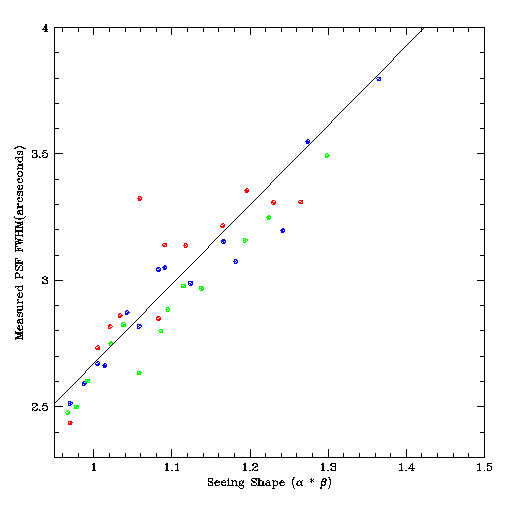
Figure 2 - Average J, H and Ks seeing
shapes for all processed scans plotted versus running survey day number.
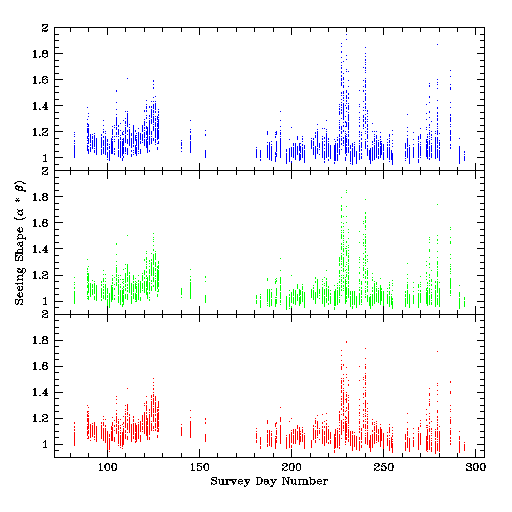
Figure 3 - Seeing shape measurement
uncertainty plotted as a function of seeing shape, for J, H and Ks
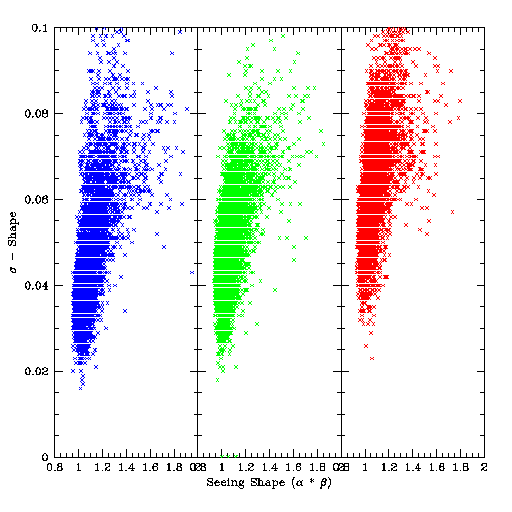
Figure 4 - Histograms of seeing
shape distributions.
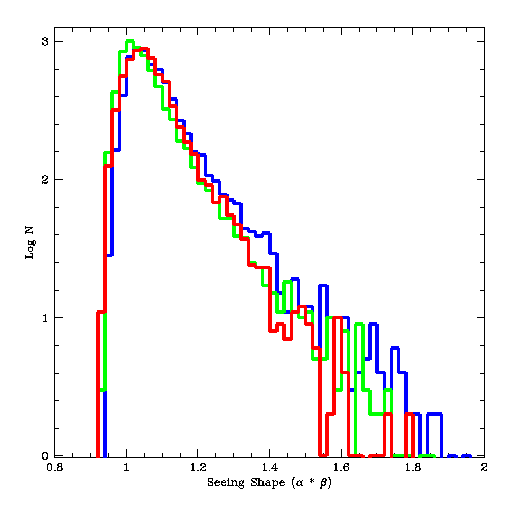
| J | J | H | H | Ks | Ks | |
| shape | FWHM(") | shape | FWHM(") | shape | FWHM(") | |
| Mode | 1.03 | 2.8 | 1.02 | 2.7 | 1.04 | 2.8 |
| Median | 1.07 | 2.9 | 1.05 | 2.8 | 1.06 | 2.9 |
| 90% | 1.23 | 3.4 | 1.19 | 3.3 | 1.20 | 3.3 |
Figure 5 - Cumulative distributions
of measured seeing shapes.
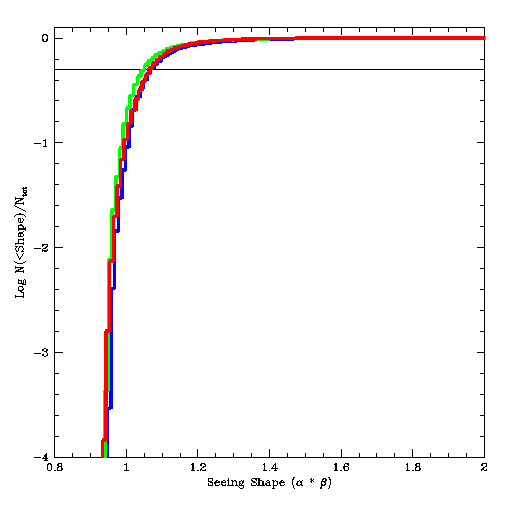
The average image symmetry is characterized during processing of each 2MASS calibration and survey scan by measuring the ratio of the cross-scan to in-scan second image moments of composite star images. These composite images are generated by combining individual star images from an entire scan. Values of the second image moment ratio (R2) larger then 1.0 indicate images elongated in the cross-scan (RA) direction, and values less than 1.0 indicate elongation in the in-scan (DEC) direction. Figure 6 shows a time history of R2 measured for all scans as a function of running survey date. Severe elongation occurred in June 1997 because the initial calibration of the auto-focus parameters were made in April and May when temperatures were significantly lower than in June. Better calibration was carried out at the beginning of July and since that time the telescope auto-focus performance has been excellent.
Figure 6 - Measured average image
second moment ratios for all processed scans plotted versus running survey
day number.
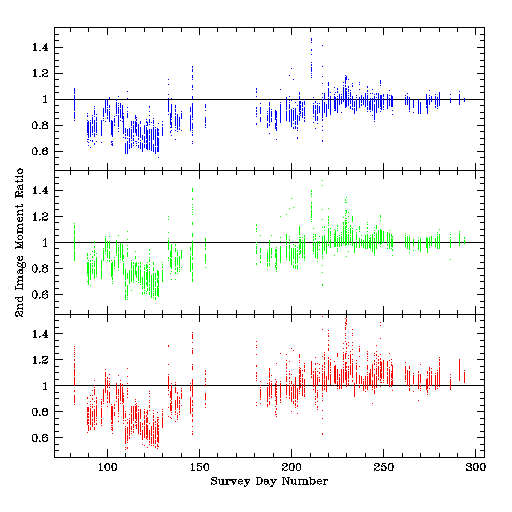
Figure 7 - Histograms of log second
moment ratios for all scans.
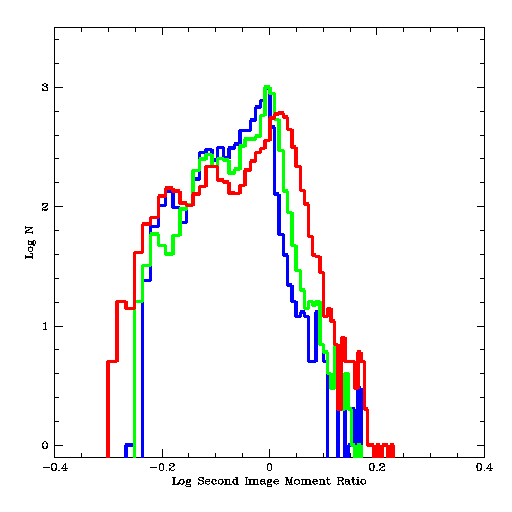
Figure 8 - Relationship between
average second moment ratio (R2) and average seeing shape for all scans.
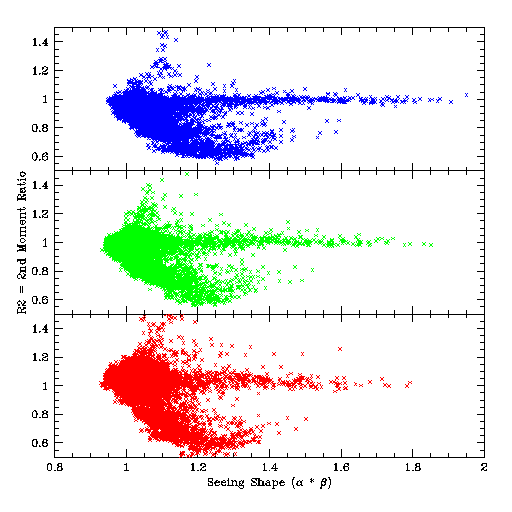
Figure 9 - Cumulative second image
moment ratio distribution for first six months of operation.
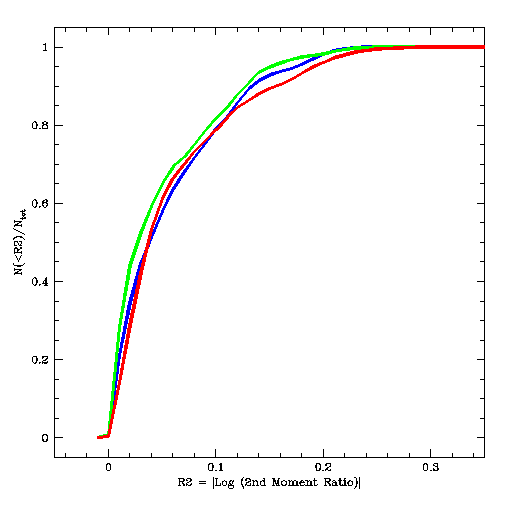
Last Update 1/24/98